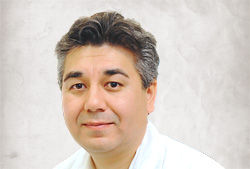
Dr. Najib Ayas
Researcher, Sleep Apnea
Dr. Ayas has researched the costs and quality-of-life improvements of CPAP therapy. He has also evaluated data on motor vehicle crashes and reviewed studies on improvements in the daily lives of patients who use CPAP therapy. His research concludes in favour of CPAP machines as the most beneficial to the patient and the most economically attractive when considering the reduction in motor vehicle crashes and lost hours in the workplace. Patients who have used CPAP machines report better sleep patterns and better daytime alertness and focus. The BC Lung Foundation grants a million dollars annually to physicians and scientists doing research in British Columbia and has been a funder of Dr. Ayas’ sleep disorders research.
Dr. Najib Ayas research explores not only the health impacts of prolonged sleep apnea but the best ways to diagnose and treat it, and the overall costs to society when sleep apnea goes untreated.
What is sleep apnea?
When we sleep, the muscles in the back of the throat relax, causing it to narrow. If it narrows too much, you are trying to push air through a very narrow tube and it causes a lot of vibrations and snoring. Apnea means that when monitored, a patient can’t breathe for 10 seconds. If your airway shuts more than 30 times, you have severe apnea.
Why study sleep apnea?
Sleep is a very young research field. Sleep apnea per se was only described in the 1980s and the CPAP treatment has only been around since the 80s as well, so there seems to be a lot of work that could be done to improve the condition. Unfortunately, for a lot of respiratory diseases, people don’t really get that much better. What I like about sleep apnea patients is that there is very effective treatment which can literally change lives – it allows patients to be much more productive.
How serious of a health disorder is sleep apnea?
Lack of sleep affects our ability to concentrate and stay alert. The effects can vary from daytime sleepiness, neurocognitive impairment and decreased learning skills to more long-term health effects such as cardiovascular disease, diabetes, obesity and hypertension. One study shows that over a 12-year period, patients with severe, untreated sleep apnea have a much higher rate over time of fatal cardiovascular events.
In what way does sleep apnea become a societal concern?
Lack of sleep affects our ability to concentrate and stay alert. My research shows that the societal and economic costs of undiagnosed and untreated sleep apnea are substantial. For example, patients with the condition have a significantly greater risk of motor vehicle crashes, consume more health-care resources, and have associated annual costs in the billions of dollars per year including work disability, absenteeism and work-related injuries.
How people find out if they have sleep apnea?
Symptoms include snoring, gasping, choking, constant waking, raised blood pressure, increased trips to the bathroom and morning headaches, however these symptom can also be associated with other conditions. So if a sleep disorder is suspected, I work with patients to determine the best way to reach a diagnosis. The patient is usually monitored during usual sleeping hours. They can choose from home monitoring with a pulse oxymeter, a simple device that measures oxygen levels in the blood, or an in-laboratory polysomnography. This test requires a patient to stay overnight in a sleep laboratory and involves more sophisticated monitoring of brain activity, heart rate, snoring, body movements, and more. While the in-lab testing is more involved for both patient and lab, and more expensive, Dr. Ayas’ research demonstrates that in-lab testing can help to diagnose a greater range of sleep disorders and help to avoid false positives and false negatives.
What happens once a patient is diagnosed?
Once diagnosed, patients have a few options. In the very obese, weight loss is advised to reduce the amount of pressure on the airway from added weight around the neck area. Smoking and alcohol consumption can exacerbate the condition so should be avoided. In some cases, custom fitted dental appliances can help to keep the airway open at night, and in rare cases, surgery to modify the upper airway is an option. In most cases, however, the common form of treatment is the continuous positive airway pressure (CPAP) machine.
